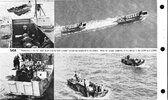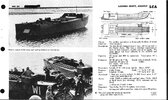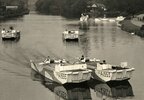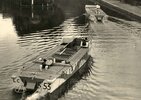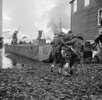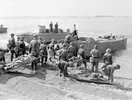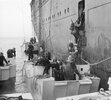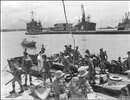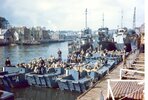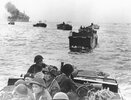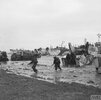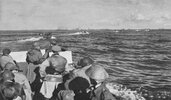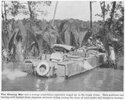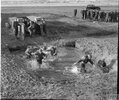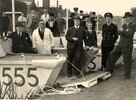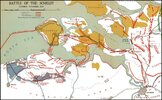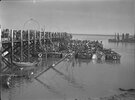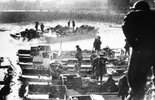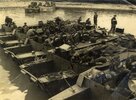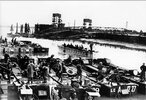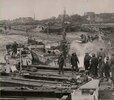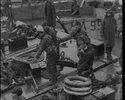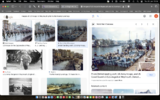- Joined
- Apr 28, 2018
- Messages
- 10,809
- Points
- 113
- First Name
- Jakko
Earlier this year, or maybe late last year, Gecko released a 1:35 scale kit of the British Landing Craft, Assault, a small craft designed in the Second World War for carrying infantry onto hostile beaches. After I finish my Churchill AVRE with SBG bridge, I will move on to this one that is also of local interest to me. However, history of the craft as well as details on how it was used in my area will follow in a later post, after I cover the model 
The Gecko kit comes in a pretty large box, 41 cm × 25 cm × 9 cm in size:
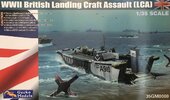
It has the usual lid that comes off, but it’s on so tight it doesn’t really want to — once I got it off, I tried to put it back on and take it off again, and that was still difficult. I then broke the glue in one of the corners, so the lid is on much looser now Under that lid, though, is not a tray like you would expect, but a cardboard box with a flip-up lid, of the design used to send things through the mail. I have a feeling I will be cutting that lid off, because it will only get in the way otherwise when I’m actually building the model.
Under that lid, though, is not a tray like you would expect, but a cardboard box with a flip-up lid, of the design used to send things through the mail. I have a feeling I will be cutting that lid off, because it will only get in the way otherwise when I’m actually building the model.
The reason for the size of the box soon becomes clear:
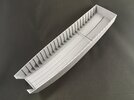
That hull is about 34 cm long, 9 cm wide and 4.5 cm high, moulded in one piece and (by the looks of it) quite straight. I’m pretty impressed so far.
The other sprues you get are also all in light grey plastic:
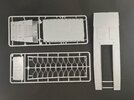
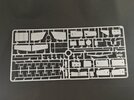
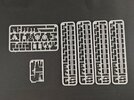
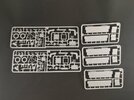
This is all the sprues, including all duplicates you get. Most of the parts are for the boat itself, but in the last picture, all three G-sprues and some parts on the F-sprues are for wooden blocks that you can pose the finished model on, either on its own or you could use them for a diorama with the boat out of the water, for example undergoing maintenance.
And there’s a tiny bit of etched brass, two different thicknesses of thread, and a decal sheet:
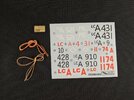
You also get instructions, of course, but see Scalemates for those, where I uploaded a PDF of them a few months ago, soon after I bought the kit.
There are some options provided. You can build the bow ramp and armoured doors open or closed, and the same goes for the armoured flaps over the steering position. The steering position itself has two different armour layouts, with alternative parts provided, and you also get two different engine room hatches for the rear deck to go along with them, either one circular hatch in the middle or a square one either side of the centreline. Also different tie-down cleats for around the deck, and though the kit doesn’t explicitly say so, you can leave out the benches for the infantry in the hold, as those were removable on the real boat.
Unfortunately, one option that isn’t catered for is the armament: you only get a Bren gun, when the real craft were equipped at least as often with a Lewis gun instead (the aircraft version without the chimney around the barrel, as far as I can tell).
The painting and marking options are, IMHO, a bit of a missed opportunity. Five options are provided: two grey boats, one during training of US troops in the UK in early 1944 and the other used for landing American troops at Algeria in November 1942, plus three camouflaged boats used on Gold Beach in Normandy on 6 June 1944. The grey boats look OK to me, but for the camouflaged ones the wrong colours are indicated and the pattern can’t be right for all of them — it doesn’t conform to official drawings, and though individual boats often deviated from that, I doubt all three would deviate in exactly the same way … The use of black pennant numbers on D-Day is also suspect, though it could be possible.
I call it a missed opportunity because schemes and markings could easily have been provided for boats used in Commando operations in Norway, in Egypt, at Walcheren, in the Rhine crossings, in Burma, and probably in several other places. I guess Gecko figured that more Normandy options means it will sell better?
Still, if this kit assembles as well as it looks, this should be a good one.

The Gecko kit comes in a pretty large box, 41 cm × 25 cm × 9 cm in size:

It has the usual lid that comes off, but it’s on so tight it doesn’t really want to — once I got it off, I tried to put it back on and take it off again, and that was still difficult. I then broke the glue in one of the corners, so the lid is on much looser now
 Under that lid, though, is not a tray like you would expect, but a cardboard box with a flip-up lid, of the design used to send things through the mail. I have a feeling I will be cutting that lid off, because it will only get in the way otherwise when I’m actually building the model.
Under that lid, though, is not a tray like you would expect, but a cardboard box with a flip-up lid, of the design used to send things through the mail. I have a feeling I will be cutting that lid off, because it will only get in the way otherwise when I’m actually building the model.The reason for the size of the box soon becomes clear:

That hull is about 34 cm long, 9 cm wide and 4.5 cm high, moulded in one piece and (by the looks of it) quite straight. I’m pretty impressed so far.
The other sprues you get are also all in light grey plastic:




This is all the sprues, including all duplicates you get. Most of the parts are for the boat itself, but in the last picture, all three G-sprues and some parts on the F-sprues are for wooden blocks that you can pose the finished model on, either on its own or you could use them for a diorama with the boat out of the water, for example undergoing maintenance.
And there’s a tiny bit of etched brass, two different thicknesses of thread, and a decal sheet:

You also get instructions, of course, but see Scalemates for those, where I uploaded a PDF of them a few months ago, soon after I bought the kit.
There are some options provided. You can build the bow ramp and armoured doors open or closed, and the same goes for the armoured flaps over the steering position. The steering position itself has two different armour layouts, with alternative parts provided, and you also get two different engine room hatches for the rear deck to go along with them, either one circular hatch in the middle or a square one either side of the centreline. Also different tie-down cleats for around the deck, and though the kit doesn’t explicitly say so, you can leave out the benches for the infantry in the hold, as those were removable on the real boat.
Unfortunately, one option that isn’t catered for is the armament: you only get a Bren gun, when the real craft were equipped at least as often with a Lewis gun instead (the aircraft version without the chimney around the barrel, as far as I can tell).
The painting and marking options are, IMHO, a bit of a missed opportunity. Five options are provided: two grey boats, one during training of US troops in the UK in early 1944 and the other used for landing American troops at Algeria in November 1942, plus three camouflaged boats used on Gold Beach in Normandy on 6 June 1944. The grey boats look OK to me, but for the camouflaged ones the wrong colours are indicated and the pattern can’t be right for all of them — it doesn’t conform to official drawings, and though individual boats often deviated from that, I doubt all three would deviate in exactly the same way … The use of black pennant numbers on D-Day is also suspect, though it could be possible.
I call it a missed opportunity because schemes and markings could easily have been provided for boats used in Commando operations in Norway, in Egypt, at Walcheren, in the Rhine crossings, in Burma, and probably in several other places. I guess Gecko figured that more Normandy options means it will sell better?
Still, if this kit assembles as well as it looks, this should be a good one.

